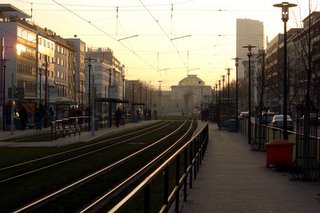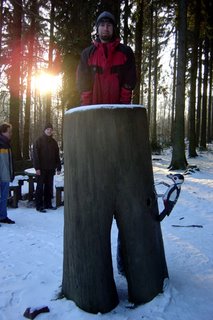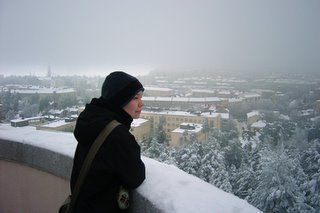Today I'm thankful for down jackets and mittens. Click here: January 27, 2006
5 weeks ago
ordinary life in the far north is not always ordinary. even for a couple of geeks.
 After the exciting trip to the top of Pyynikinharju, it was time for some bier und brezelen. Inari, her sister Anu, and myself visited our friend Rolland who lives in Mannheim, Germany. From the tourist’s point of view, Mannheim leaves something to be desired. It was destroyed during WWII and quickly re-built with cheap supplies, so that it lost much of the character it once had. But it is maybe the more realistic Germany (when compared to popular tourist destinations), and that made it quite interesting, especially with a local guide who was excited to show us around and answer my millions of questions about Nazism, WWII, the re-unification of Germany, the German economy, and the philosophy of beer. I’ve come to the realization that I really do enjoy learning history (previously I thought it was boring), but not the history that you learn in textbooks.
After the exciting trip to the top of Pyynikinharju, it was time for some bier und brezelen. Inari, her sister Anu, and myself visited our friend Rolland who lives in Mannheim, Germany. From the tourist’s point of view, Mannheim leaves something to be desired. It was destroyed during WWII and quickly re-built with cheap supplies, so that it lost much of the character it once had. But it is maybe the more realistic Germany (when compared to popular tourist destinations), and that made it quite interesting, especially with a local guide who was excited to show us around and answer my millions of questions about Nazism, WWII, the re-unification of Germany, the German economy, and the philosophy of beer. I’ve come to the realization that I really do enjoy learning history (previously I thought it was boring), but not the history that you learn in textbooks. Besides being in Mannheim we also spent one day in Worms, an old Jewish center on the River Rhein that has the oldest Jewish cemetery in Europe, and two days in Heidelberg, a popular tourist spot that was not bombed during WWII because some important American was fond of the city. I’m pretty sure I was there 10 years ago with my family, but I didn’t realize that until Rolland bought a bratwurst from what I think is the same vender that I bought one from 10 years ago (I didn’t remember the person, just the place). Heidelberg has many things to keep a visitor busy, including castle and monastery ruins, a lovely old town, the philosopher’s walk, a fairy tale park, and a Nazi theater. Our guide book said that the fairy tale park is a delight for kids, in which case I’m still a kid!
Besides being in Mannheim we also spent one day in Worms, an old Jewish center on the River Rhein that has the oldest Jewish cemetery in Europe, and two days in Heidelberg, a popular tourist spot that was not bombed during WWII because some important American was fond of the city. I’m pretty sure I was there 10 years ago with my family, but I didn’t realize that until Rolland bought a bratwurst from what I think is the same vender that I bought one from 10 years ago (I didn’t remember the person, just the place). Heidelberg has many things to keep a visitor busy, including castle and monastery ruins, a lovely old town, the philosopher’s walk, a fairy tale park, and a Nazi theater. Our guide book said that the fairy tale park is a delight for kids, in which case I’m still a kid!
 I was unable to confirm whether Pyynikinharju is the highest moraine ridge in the world for a few reasons:
I was unable to confirm whether Pyynikinharju is the highest moraine ridge in the world for a few reasons:
At any rate, it’s a beautiful place with great views of the city of Tampere and the two large lakes that surround it. So far it’s my favorite city in Finland.